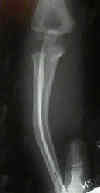- See:
- Greenstick Frx of Distal Radius & Ulna
- Green Stick Frxs of Mid 1/3 of Radius & Ulna
- Discussion:
- frx may be incomplete (greenstick) in radius and/or ulna, or the frx may be complete in one bone and incomplete (green stick) in the other;
- eg. complete radius and green stick ulna;
- anatomy:
- incomplete long bone frx, w/ failure of cortex on tension side (convex side of angulation) w/ plastic deformation of cortex on concave side;
- angulation:
- note that the normal ulna should have a completely straight posterior border on the lateral radiograph;
- may be dorsal, volar, or toward or away from interosseous membrane
- dorsal fracture sustained with forearm in pronation
- volar fracture sustained with forearm in supination
- Workup:
- when only 1 bone of forearm is broken, integrity of the proximal & & distal radioulnar joints needs to be evaluated;
- w/ "isolated" ulnar shaft green stick frx, always check for radial head tenderness, which would indicate a Monteggia frx eqivalent, in which there has been spontaneous reduction of the radial head;

- Managment:
- green stick frxs of mid 1/3 of radius & ulna:
- overcorrection of fracture may be required (completing the fracture)
- these do not require reduction if dorsal angulation is insignificant;
- acceptable reduction:
- infants:
- up to 30 deg may be accepted;
- consider reduction w/ completion of frx by reversal of deformity if angulation > 25-30 deg;
- children:
- up to 15 deg may be accepted depending on age of patient;
- there is no need to attempt correction for angulation measuring < 10 deg in children less than 10 yrs of age;
- reduction:
- a volarly angulated greenstick frx is manipulated w/ forearm in pronation while a dorsally angulated frx is manipulated w/ forearm in supination;
- during manipulation, deformity is reversed, so that the distal frag is angulated toward volar aspect until intact dorsal cortex is fractured;
- following reduction, need 3 Point Molding to keep tension on intact periosteal hinge.
- long arm cast is applied after forearm gently rotated into supination;
- long arm cast is applied for a period of 4 to 6 weeks;
- even minimally angulated greenstick frx can angulate more in a cast so consider reduction if anguation exceeds 10 deg or more;
- in these green stick frxs, if the cortex is not completely broken thru, increasing deformity may occur;
- Complications:
- recurrent deformity w/in cast is number one problem w/ green stick frx
- recurrent angulation is more likely w/ volar rather than dorsal;
- charnley noted that recurrent angulation is esp common in radial green stick frx with an intact ulna;
- median nerve entrapment
Dorsally angulated solitary metaphyseal greenstick fractures in the distal radius: results after immobilization in pronated, neutral, and supinated position.
Angular remodeling of midshaft forearm fractures in children.
Forearm fractures in children. Cast treatment with the elbow extended.



